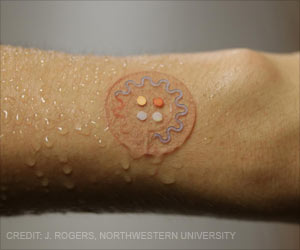- Sweat as a Source of Next-Generation Digital Biomarkers - (https://pubmed.ncbi.nlm.nih.gov/32095774/)
- Sweat diagnostics - (https://en.wikipedia.org/wiki/Sweat_diagnostics)
- De Giovanni N. and Fucci N., The Current Status of Sweat Testing For Drugs of Abuse: A Review, Current Medicinal Chemistry 2013; 20(4). - (https://dx.doi.org/10.2174/0929867311320040006)
- Wearable Sweat Biosensors Refresh Personalized Health/Medical Diagnostics - (https://pubmed.ncbi.nlm.nih.gov/34778790/)
About
In recent years, the world of healthcare has witnessed a revolutionary paradigm shift with the advent of digital biomarkers. These next-generation indicators provide unprecedented insights into a person's health, paving the way for personalized and preventive medicine.
One promising frontier in this domain is iSudorology, the study of sweat as a valuable source of biomarkers. This article delves into the fascinating realm of iSudorology, exploring its history, working principles, advantages, and disadvantages.
Traditionally, biomarkers have predominantly been associated with blood tests. However, iSudorology redefines this notion by harnessing the potential of sweat as a non-invasive and informative medium for health assessment. This innovative field involves the analysis of sweat's chemical composition and physical properties to extract valuable health-related data(1✔ ✔Trusted Source
Sweat as a Source of Next-Generation Digital Biomarkers
Go to source).
History of iSudorology
The roots of iSudorology can be traced back to ancient civilizations that recognized the significance of sweat in understanding human health. Ancient Greek physicians, for instance, employed sweat as a diagnostic tool. However, the modern resurgence of iSudorology owes much to the development of smart biosensors and advancements in miniaturization technologies(1✔ ✔Trusted Source
Sweat as a Source of Next-Generation Digital Biomarkers
Go to source).
Working Principle of iSudorology
iSudorology operates on the principle that sweat carries a treasure trove of information about an individual's health. The process begins with the collection of sweat samples through various techniques, including wearables and on-skin sensors. These sensors, often integrated with smartphones, analyze the sweat's composition and provide real-time data(2✔ ✔Trusted Source
Sweat diagnostics
Go to source).
What are the Advantages of iSudorology?
As game-changer in healthcare, iSudorology offers a multitude of advantages that make it a game-changer in healthcare:
Non-Invasive Technique
Unlike traditional blood tests, which can be uncomfortable and invasive, sweat analysis is non-invasive. It eliminates the need for needles and provides a painless alternative for health monitoring.
Real-Time Data
One of the significant advantages of iSudorology is its ability to provide real-time data. Smartphone-based biosensors can instantly transmit information, enabling timely interventions and personalized recommendations.
Patient-Driven Sweat Analysis
With iSudorology, individuals can take charge of their health. Patients can easily collect sweat samples at their convenience, making it a patient-driven approach to healthcare.

Clinical Sweat Research
The clinical implications of iSudorology are vast. Researchers can explore various aspects of health, including metabolic disorders, dehydration, and stress, through sweat diagnostics.
Wearable Integration
Wearable devices equipped with sweat analysis sensors have made continuous health monitoring a reality. These wearables seamlessly integrate with our daily lives, providing a continuous stream of health-related data(3✔ ✔Trusted Source
De Giovanni N. and Fucci N., The Current Status of Sweat Testing For Drugs of Abuse: A Review, Current Medicinal Chemistry 2013; 20(4).
Go to source).
What are the Disadvantages of iSudorology?
While iSudorology holds immense promise, it's essential to acknowledge its limitations:
Sweat Sampling Variability
Sweat composition can vary significantly among individuals and even in the same person under different conditions. This variability poses a challenge in establishing consistent baseline data.
Standardization
The field of iSudorology is still in its nascent stages, lacking standardized protocols and reference values. This can lead to variations in interpretation and diagnosis.
Technical Challenges
Developing accurate and reliable sweat analysis sensors can be technically challenging. Ensuring the sensors' precision and stability is critical for their widespread adoption(4✔ ✔Trusted Source
Wearable Sweat Biosensors Refresh Personalized Health/Medical Diagnostics
Go to source).
Limited Biomarker Scope
Sweat analysis primarily focuses on a specific set of biomarkers. While it offers valuable insights into certain health aspects, it may not cover the breadth of information provided by traditional blood tests.
Data Privacy Concerns
Collecting and transmitting health data over the internet raises concerns about data security and privacy. Robust safeguards must be in place to protect sensitive information
Cost and Accessibility
Advanced sweat analysis tools and wearables can be costly, limiting their accessibility to certain populations. This cost factor raises equity concerns in healthcare.
Conclusion
iSudorology represents a transformative shift in healthcare, harnessing the potential of sweat as a valuable source of digital biomarkers. By offering non-invasive, real-time insights into an individual's health, it has the potential to revolutionize diagnostics, monitoring, and preventive care. However, it is essential to address the challenges associated with sweat analysis, such as variability and standardization, to fully unlock its potential.
With these innovations, the field holds the promise of becoming an indispensable component of modern healthcare, enabling us to monitor and manage our health in ways we never thought possible.









